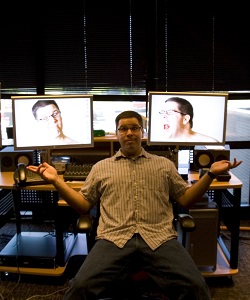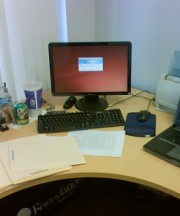
Dual-monitor envy is common and understandable.
You’ve seen your buddy sitting there looking like an air-traffic controller — vast fields of spreadsheets that look to contain all the world’s information.
Plus: two monitors. Two is better than one, right?
But it may not be the case that you’ll get better work results with dual monitors, either in terms of quality or quantity.
Here are some issues with dual monitors, as well as a discussion of the differences between dual and single monitors.
The Too Much Factor
The way most people use dual monitors for work is to have one big desktop. When you drag, say, a Word document to the far edge of the right-hand monitor, it just stays there, rather than appearing on both monitors at the same time.
This allows for many different applications to be open at once, none of them partially covering the other. The intrepid bookkeeper, writer, graphic designer or entrepreneur then plucks information from each window, synthesizing it as needed.
The only problem with this approach is that having too much information to sift through doesn’t necessarily increase speed. Is it necessarily better to swivel your head back and forth to locate the right spreadsheet? Or would it be more effective to have it sitting down in your tray? You know where it is and can open it when you need it.
The Multi-Task Morass
If you’re using two monitors, say, to create a report, having research over here and your Word document over there, that’s one thing.
But if you’re using it to chat with a client while doing some invoices on the side when your chat partner takes too long to respond, with some job searching thrown in (insert endless combos here) your results may suffer.
With your attention thus divided, are you giving thoughtful replies to your client? Are you invoicing correctly? The evidence that incriminates multi-tasking is substantial.
Size Matters
Without a doubt, dual monitors give you what looks like a monstrous field for monster work. But a lot of the hype about dual monitors came out several years ago when monitors were quite a bit smaller. The way to get working space was the magic of addition.
Now, though, monitors are pretty wide, particularly with laptops. And if you want to go out and buy a wide monitor, they’re in the store waiting, and they’re not terribly expensive these days.
Having your info on one big ole monitor means not having to ask yourself which monitor which document is on, not breaking your neck with swiveling, etc. And IT writer Wallace Chu makes the shrewd observation that “a 1440p monitor offers more real estate than two 720p monitors.”
So, yes, it can be good to have multiple windows open at once if that suits your working style. But that doesn’t mean that two monitors is the way to get there.
Also, if people find out you have dual monitors, they’ll expect you to do twice the work. Ask around some, and if you decide dual monitors are the way to go for you, then go for it. But don’t allow yourself to get sucked into the hype that says they increase productivity.







I appreciate your point of view but I have a different one.
I never work with less than 2 computers (notebooks)and a tablet on my desk additionally 4 monitors 2 to each notebook .
Now there are merits in what you had to say in your article but different strokes for different folks .
First off by trade I am a construction estimator but I am also a webmaster and blogger often I am involved with desktop publishing and computer design.
I suggest to you that my layout is like the top of a busy persons desk 30 years ago he may have multiple projects on the go and it helped a great deal to spread out his work as much as possible.
I also find colleagues misunderstand the technology and once i explain some of the extreme benefits there is less hostility towards what I call desktop networking.
I strongly urge any one to try and control multiple computers from a single keyboard and mouse it is truly liberating to simultaneously be able to run say OCR on 500 page document while on another computer work on a huge diagram or drawing and have screens with various live input remain in full view .
Does it make me more productive ?I think it makes me more in control I can in essence project manage in a dimensional sense vs a list or schedule approach.
For bloggers this is a no brainer as well as anyone in research or just plain anyone who has a lot to do .
I have extensive experience working with both a single monitor and a dual-monitor setup. And I can say that, without any doubt, I get more done with two monitors — a lot more. I’ve also never had anyone make a crazy assumption about multiple monitors meaning I could, or should, do twice the work. I know plenty of freelancers who use this setup, and I’ve never heard of any of them facing such a silly expectation from clients. If you did, that sucks. But readers should know that’s far from the norm.
My husband is also a freelancer — a software developer. He actually uses a three-monitor setup. And again, it has a tremendous impact on his productivity. One of his monitors recently failed, and it’s been a big struggle managing with just two until he picks a new one.
Only you know what works for you and your business. But I hope no one reads this and lets it immediately turn them off from a multi-monitor setup. Some of the most productive freelancers I know use at least two.
I have to agree with Jennifer – as a designer and animator it’s very difficult to function with only one monitor. For maya it’s great having your viewports and shot cam on one screen and your graph editor open on the other. Same goes for any video production in premiere/after effects I always stretch my timelines across both screens.
Guess it depends on what your job function is. If your doing more business admin with office applications you might not need two screens, but now a days for designers or any creative field it’s a must have!
Thanks, Nicole. I dabble in video editing and since I don’t use a dual monitor, I had no idea you could stretch timelines across two screens! If you’re integrating work like that across screens then issues of burying yourself in different documents don’t really apply. Thanks!